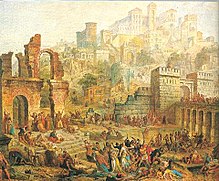Massacres na Renânia
Os massacres da Renânia, também conhecidos como Cruzada Alemã de 1096[1] ou Gzerot Tatnó (em hebraico: גזרות תתנ"ו, "Éditos de 4856"), foram uma série de assassinatos em massa de judeus perpetrados por multidões de cristãos franceses e alemães da Cruzada Popular no ano de 1096 (4856 no calendário hebraico). Estes massacres são frequentemente vistos como o primeiro de uma sequência de eventos antissemitas na Europa que culminaram no Holocausto.[2]

Os líderes proeminentes dos cruzados envolvidos nos massacres incluíam Pedro, o Eremita, e especialmente o Conde Emicho.[3] Como parte desta perseguição, a destruição das comunidades judaicas em Speyer, Worms e Mainz foi notada como Hurban Shum (Destruição de Shum). Essas foram novas perseguições aos judeus, nas quais cruzados camponeses da França e da Alemanha atacaram comunidades judaicas. Vários historiadores referiram-se à violência como pogroms.[4]
Referências
- ↑ Gilbert, M. (2010). The Routledge Atlas of Jewish History. [S.l.]: Routledge. ISBN 978-0415558105. Consultado em 5 de outubro de 2014
- ↑ David Nirenberg (2002). Gerd Althoff, ed. Medieval Concepts of the Past: Ritual, Memory, Historiography. [S.l.]: Cambridge University Press. pp. 279–. ISBN 978-0-521-78066-7
- ↑ Chazan, Robert (1996). European Jewry and the First Crusade. [S.l.]: U. of California Press. pp. 55–60, 127. ISBN 978-0520917767
- ↑ Sources describing these attacks as pogroms include:
- Richard S. Levy. Antisemitism: A Historical Encyclopedia Of Prejudice And Persecution, ABC-CLIO, 2005, ISBN 978-1851094394, p. 153.
- Christopher Tyerman. God's War: A New History of the Crusades, Harvard University Press, 2006, ISBN 978-0674023871, p. 100.
- Israel Jacob Yuval. Two Nations in Your Womb: Perceptions of Jews and Christians in Late Antiquity and the Middle Ages, University of California Press, 2008, ISBN 978-0520258181, p. 186.
- Nikolas Jaspert. The Crusades, Taylor & Francis, 2006, ISBN 978-0415359672, p. 39.
- Louis Arthur Berman. The Akedah: The Binding of Isaac, Jason Aronson, 1997, ISBN 978-1568218991, p. 92.
- Anna Sapir Abulafia, "Crusades", in Edward Kessler, Neil Wenborn. A Dictionary of Jewish-Christian Relations, Cambridge University Press, 2005, ISBN 978-0521826921, p. 116.
- Ian Davies. Teaching the Holocaust: Educational Dimensions, Principles and Practice, Continuum International Publishing Group, 2000, ISBN 978-0826448514, p. 17.
- Avner Falk. A Psychoanalytic History of the Jews, Fairleigh Dickinson University Press, 1996, ISBN 978-0838636602, p. 410.
- Hugo Slim. Killing Civilians: Method, Madness, and Morality in War, Columbia University Press, 2010, ISBN 978-0231700375, p. 47.
- Richard A. Fletcher. The Barbarian Conversion: From Paganism to Christianity, University of California Press, 1999, ISBN 978-0520218598, p. 318.
- David Biale. Power & Powerlessness in Jewish History. Random House, 2010, ISBN 978-0307772534, p. 65.
- I. S. Robinson. Henry IV of Germany 1056–1106, Cambridge University Press, 2003, ISBN 978-0521545907, p. 318.
- Will Durant. The Age of Faith. The Story of Civilization Vol. 4, Simon & Schuster, 1950, p. 391.
Bibliografia
editar- Charny, Israel W. (1994). The Widening Circle of Genocide. [S.l.: s.n.] ISBN 978-1560001720 Verifique o valor de
|url-access=registration(ajuda) - Chazan, Robert (1987). European Jewry and the First Crusade. [S.l.]: University of California Press
- Chazan, Robert (1996). In the Year 1096: The First Crusade and the Jews. [S.l.]: Jewish Publication Society. ISBN 978-0827606326 Verifique o valor de
|url-access=registration(ajuda) - Claster, Jill N. (2009). Sacred Violence: The European Crusades to the Middle East, 1095–1396. [S.l.]: University of Toronto Press. ISBN 978-1442600607
- Cohen, Jeremy (2004). Sanctifying The Name of God: Jewish Martyrs and Jewish Memories of the First Crusade. [S.l.]: University of Pennsylvania Press
- Eidelberg, Shlomo (1996). The Jews and the Crusaders. [S.l.]: KTAV Publishing House. ISBN 978-0881255416
- Hoffman, Lawrence A. (1989). Beyond the Text: A Holistic Approach to Liturgy. [S.l.]: Indiana University Press. ISBN 978-0253205384
- Nirenberg, David. «The Rhineland Massacres of Jews in the First Crusade, Memories Medieval and Modern*». Medieval Concepts of the Past: Ritual, Memory, Historiography
- Reif, Stefan C. (1995). Judaism and Hebrew Prayer. [S.l.]: Cambridge University Press. ISBN 978-0521483414
- Shwartz, Susan (2002). Cross and Crescent. [S.l.]: Open Road Integrated Media, Incorporated. ISBN 978-0759212923
- Tartakoff, Paola (2012). Between Christian and Jew: Conversion and Inquisition in the Crown. [S.l.]: University of Pennsylvania Press, Incorporated. ISBN 978-0812244212
- Tyerman, Christopher (2009). The Crusades. [S.l.]: Sterling Publishing Company. ISBN 978-1402768910
- Vauchez, André; Dobson, Richard Barrie; Lapidge, Michael (2000). Encyclopedia of the Middle Ages. 1. [S.l.: s.n.] ISBN 978-1579582821